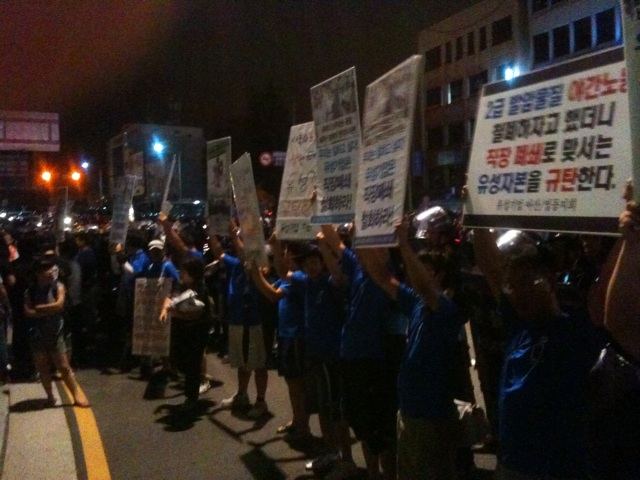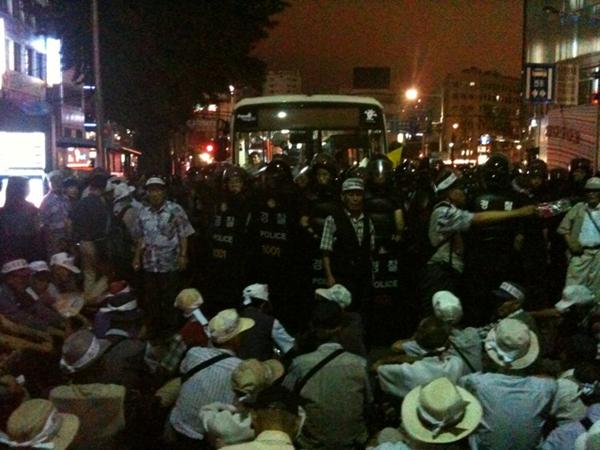Location:
Since the 1980s, South Korea has become famous for the militancy of its labor movement. Korean workers movements have been successful in launching many large-scale strikes and protests since the demise of South Korea’s authoritarian regime in 1987. Though the labor movement has achieved much since the democratic transition, such protests often meet repression from the state. This seems to be the current situation with an interesting hybrid of labor conflict and social movement that has catalyzed in what has been dubbed the “Bus of Hope Movement.” Over the past two months popular support has emerged striking workers at Hanjin Heavy Industries’ shipyard located on the the small Island of Young-Do in Busan, South Korea.
Saturday evening, July 30, 2011, the Buses of Hope continued its campaign. Eager to watch the drama unfold, I headed to the offices of the city’s major newspaper the Busan Ilbo to join a small team of journalists who where preparing to spend the entire night covering the event. Saturday was the “3rd Stage” of the Bus of Hope Movement, which began on June 11th when the famous poet Song Young-Dong led 600 people on buses from Seoul to the Hanjin shipyard where they would protest in solidarity with the 51 year old welder and labor representative Kim Jin-Sook.
Ms. Kim has been perched 115 feet above the ground on the infamous crane #85 at the shipyard. On January 6th Ms. Kim climbed to the top and began her protest against Hanjin laying off more than 400 workers. Her actions have been presented by Hanjin management and rightwing opposition groups as an isolated protest by a woman who does not represent the real interests of the workers. However her standoff with management is part of a longer struggle that has been ebbing-and-flowing over the past ten years. Drawing attention to this larger struggle, Ms. Kim strategically chose crane #85 to perch herself. This crane is a symbolically powerful symbol of the conflict because it is where another trade unionist, Kim Ju-Ik, hung himself in 2003 after spending 129 days in the crane as he saw no compromise in sight.
Hanjin Management has become frustrated with the Bus of Hope movement labeling the participants outside agitators. The anger and tension has grown as has the movement. On July 9th, the Bus of Hope Movement became of national importance as 185 buses, in commeration of Kim Jin-Sook’s 185 days in the crane, brought some 7,000 supporters to Busan with the intent of meeting Kim Jin-Sook at the Hanjin Shipyard. In response to this spike in participation Hanjin Management requested “governmental authority” to get support of the police to form a blockade to keep the "Hope Riders" from crane #85. Indeed, the July 9th protest became violent as the police and Hanjin’s private security forces used water cannons and tear gas to block the protesters from arriving at Kim Jin-Sook’s crane.
Two weeks later, with Kim Jin-Sook’s 200th day in the crane looming, the Bus of Hope protest organizer Song Young-Don put together plans of what was suppose to be the largest protest. However, the authorities redoubled their efforts to contain the protest as Busan District Court Judge filed 26 charges against Song for violating laws on assembly and demonstration. As we moved from the rally to the bridge, this tension was palpable. The police were well-organized and came in large numbers. Two of the journalists who accompanied me were very nervous and weary about the possibility of violence. Haggard and tired from covering the event since the early morning they had received notice that a rightwing citizen’s group and the police were lining up at the bridges to keep buses from entering Young-Do Island and making their way to the shipyard. As we watched the organizers of the rally offer speeches, interspersed with a variety of entertainers (from traditional Korea dance to break dancing to American gangster-rap), we were following reports about the teeming of riot police at the nearby bridge. In fact there were 7,000 riot police.
At 9 pm, when the rally was scheduled to begin its crossing of the bridge, we moved to the bridge where we were met with the stunning presence of several hundreds of riot police. Traffic backed up for at least a mile as the police would not let anyone who did not have proof they were residents onto the island. The police were boarding public buses in their quest to keep all protesters off the island. Despite the intensity on behalf of the police, the rally continued in the vein of non violence as the protesters continued their vigil at the train station throughout the night.
Hanjin Management and governmental officials have tried to present the Bus of Hope Movement as "outside agitators" who have no business being involved in this local labor dispute. What they are missing is that Kim Jin-Sook's actions have resonated strongly with the feelings of vulnerability and weakness that an increasing number of Koreans are feeling. What is most striking is the way that the Bus of Hope movement has transcended working class grievances and has galvanized many middle-classes. It is important to remember that this is happening at the same time that many Korean University students are protesting the price of tuition. If the government fails to take heed of these broad-level grievances they will only contribute to the anger and resentment that many Koreans have for the powerful conglomerates (chaebols) like Hanjin.



Saturday evening, July 30, 2011, the Buses of Hope continued its campaign. Eager to watch the drama unfold, I headed to the offices of the city’s major newspaper the Busan Ilbo to join a small team of journalists who where preparing to spend the entire night covering the event. Saturday was the “3rd Stage” of the Bus of Hope Movement, which began on June 11th when the famous poet Song Young-Dong led 600 people on buses from Seoul to the Hanjin shipyard where they would protest in solidarity with the 51 year old welder and labor representative Kim Jin-Sook.
Ms. Kim has been perched 115 feet above the ground on the infamous crane #85 at the shipyard. On January 6th Ms. Kim climbed to the top and began her protest against Hanjin laying off more than 400 workers. Her actions have been presented by Hanjin management and rightwing opposition groups as an isolated protest by a woman who does not represent the real interests of the workers. However her standoff with management is part of a longer struggle that has been ebbing-and-flowing over the past ten years. Drawing attention to this larger struggle, Ms. Kim strategically chose crane #85 to perch herself. This crane is a symbolically powerful symbol of the conflict because it is where another trade unionist, Kim Ju-Ik, hung himself in 2003 after spending 129 days in the crane as he saw no compromise in sight.
Hanjin Management has become frustrated with the Bus of Hope movement labeling the participants outside agitators. The anger and tension has grown as has the movement. On July 9th, the Bus of Hope Movement became of national importance as 185 buses, in commeration of Kim Jin-Sook’s 185 days in the crane, brought some 7,000 supporters to Busan with the intent of meeting Kim Jin-Sook at the Hanjin Shipyard. In response to this spike in participation Hanjin Management requested “governmental authority” to get support of the police to form a blockade to keep the "Hope Riders" from crane #85. Indeed, the July 9th protest became violent as the police and Hanjin’s private security forces used water cannons and tear gas to block the protesters from arriving at Kim Jin-Sook’s crane.
Two weeks later, with Kim Jin-Sook’s 200th day in the crane looming, the Bus of Hope protest organizer Song Young-Don put together plans of what was suppose to be the largest protest. However, the authorities redoubled their efforts to contain the protest as Busan District Court Judge filed 26 charges against Song for violating laws on assembly and demonstration. As we moved from the rally to the bridge, this tension was palpable. The police were well-organized and came in large numbers. Two of the journalists who accompanied me were very nervous and weary about the possibility of violence. Haggard and tired from covering the event since the early morning they had received notice that a rightwing citizen’s group and the police were lining up at the bridges to keep buses from entering Young-Do Island and making their way to the shipyard. As we watched the organizers of the rally offer speeches, interspersed with a variety of entertainers (from traditional Korea dance to break dancing to American gangster-rap), we were following reports about the teeming of riot police at the nearby bridge. In fact there were 7,000 riot police.
At 9 pm, when the rally was scheduled to begin its crossing of the bridge, we moved to the bridge where we were met with the stunning presence of several hundreds of riot police. Traffic backed up for at least a mile as the police would not let anyone who did not have proof they were residents onto the island. The police were boarding public buses in their quest to keep all protesters off the island. Despite the intensity on behalf of the police, the rally continued in the vein of non violence as the protesters continued their vigil at the train station throughout the night.
Hanjin Management and governmental officials have tried to present the Bus of Hope Movement as "outside agitators" who have no business being involved in this local labor dispute. What they are missing is that Kim Jin-Sook's actions have resonated strongly with the feelings of vulnerability and weakness that an increasing number of Koreans are feeling. What is most striking is the way that the Bus of Hope movement has transcended working class grievances and has galvanized many middle-classes. It is important to remember that this is happening at the same time that many Korean University students are protesting the price of tuition. If the government fails to take heed of these broad-level grievances they will only contribute to the anger and resentment that many Koreans have for the powerful conglomerates (chaebols) like Hanjin.


Recent comments